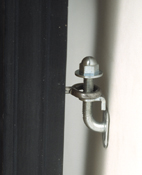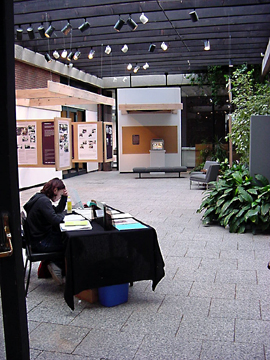If you concentrate on protecting exhibits and ignore the vulnerability of the building where they are kept, your exhibits are not protected. Your first concern should be fire and theft.
The greatest threat to collections is still fire. If it burns, it's gone, and the best of exhibit cases, alarms, or locks won't help.
Given time, proper tools, and just a bit of knowledge, a thief who gains access to your building will eventually penetrate the best of exhibit cases. Professional thieves penetrate bank vaults. They remove and haul off steel safes. Moreover, most thefts from museum collections and cultural properties are inside jobs. Staff are the culprits.
 |
| T-hanger by Temart secures paintings to walls. |
Protecting collections should begin with concentrating on these two vital areas - long before artifacts are placed on exhibit.
Fire Protection
Your building needs a sophisticated early warning smoke detection system. Devices need to be monitored by a licensed central alarm monitoring company or a proprietary central monitoring station. The system should be tested regularly, with detection devices both cleaned and tested.
During any construction periods, when systems may be deactivated, a roving patrol should inspect/observe the construction area around the clock. Strict fire prevention measures should be in place, and consistently enforced. Coordination with response agencies should be carried out in a professional manner. Fire suppression should be quick and efficient either by fire departments or automatic systems.
More Fire Protection Guidelines are in the
Cultural Property Protection Manual available from the International Foundation for Cultural Property Protection (IFCPP), American Association of Museums (
AAM), and Layne Consultants International (LCI).
Theft Prevention
Every employee should undergo a background check that looks into their history and character. Professionalize and document the entire application/hiring process. Checks should include criminal histories, verification of former employment and education, and, for anyone with access to collections, a credit history. Consider annual criminal history checks as well as initial checks upon hiring.
Policies should be in place giving management the right to inspect all containers, lockers, briefcases, backpacks -- at any time, any place on museum property. Require all employees to enter and leave through a specified entrance staffed by security personnel or under observation of a surveillance camera. Closely regulate key control and after hours access.
Guidelines for screening staff, selecting an alarm vendor, and training security staff are found in the
Cultural Property Protection Manual.
Exhibits
Now let's talk about exhibits. Exhibit cases themselves offer a variety of opportunities to improve protection. Following an exhaustive review and the input of numerous professionals, a guideline for the protection
of exhibit cases was adopted in 1997 and revised in 2008 by the American Association of Museums (AAM) and ASIS International. It may be found in
Suggested Practices for Museum Security.
Hanging Art Protection
The protection of hanging artwork isanother matter. From the use of security hangers, such as
Temart's t-hangers, to the installation of wireless artwork protection devices, there are now a number of protection alternatives.Relatively low-cost, battery operated devices (
Art Guard) protect hanging art. Other devices may transmit wireless signals to monitoring stations, or roving security officers. There are excellent systems available following a reasonable review of vendor literature and references.
Note that most general alarm manufacturers do not provide devices that protect artwork from being removed, vandalized or even approached beyond recognized barriers.
Video Surveillance
Video surveillance is a valuable tool. The quality of the video and the surveillance camera locations are important. So, too, is alert action by monitor operators. Some video providers advertise the ability of their systems to interpret actions of passersby and initiate alarms when intent to steal or vandalize is recognized. These are mostly false claims, as the systems are programmed to detect motion and not much more. When video surveillance providers claim that buyers may reduce the number of security officers by adding cameras, it's a sure sign of an inflated marketing campaign. Nothing can replace the presence of an alert, professional, well-trained security officer. Where securityofficers are not available, any staff member or volunteer may serve as a deterrent patrol.
Protecting Exhibits
There is no generic solution for protecting exhibits. You must determine the best solutions to the threats you have identified in your situation.
Protection begins with the perimeter of your building and should include a 24-hour sophisticated intrusion detection system. Roving patrols should observe all exhibits no less than once every 15 minutes. That's an arbitrary figure based on the configuration of your gallery spaces.
 |
| Work study student in university art gallery provides security presence. |
We are often asked how many officers are necessary for a given space. There is no reliable answer to that question, as the number of officers assigned should be based on many factors, including space, layout, visitor patterns, and other staffing. You may opt for physical barriers,hardened steel exhibit cases, alarms within exhibit cases, wall mounted wireless artwork protection alarms, or a combination of all of the above. We actually prefer the latter situation.
Talk to the professionals in the cultural protection business, not alarm sales representatives or vendors calling themselves consultants. If you deal with a consultant, make sure that they have no vendor connection or relationship. Not all museums boast proper electronic protection systems. Some are as antiquated as the artifacts. If you're talking to other institutions, do your best to find out how good their systems are.



